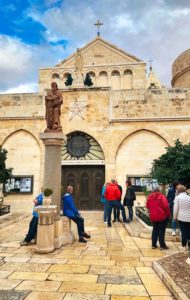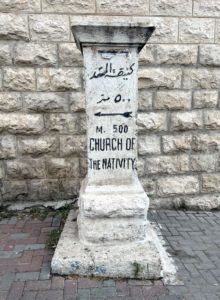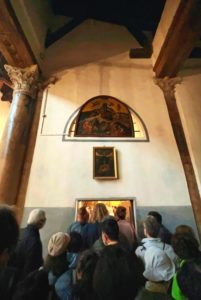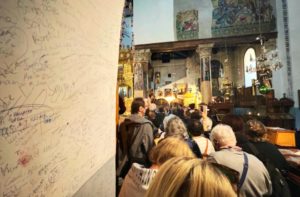Growing up, I thought Bethlehem was a “little town” in the Middle East where Mary gave birth to Jesus in an outdoor barn surrounded by livestock. If you were born in America—presumably under far more sanitary conditions—there's a good chance that you heard something similar. Yet, after recently visiting the Holy Land, I can now reveal that it's all bullsh!t.

Bethlehem wasn't even named Bethlehem.
The town of Bethlehem was initially called “Ephrath,” a perfectly good name that meant “fruitful” or “abundant.” The original name is mentioned several times in the Bible. Yet it's all but ignored by today's Christian TV producers, musicians, and filmmakers. Personally, I believe they changed the town's name because “O Little Town of Ephrath” just didn't have the same ring to it.
In fact, the name “Bethlehem” was only fully adopted after a protracted legal battle with an American town in Pennsylvania. Bethlehem, Pennsylvania was founded in the state's Lehigh Valley region by one of the oldest Protestant denominations in Christianity, dating back to the 15th century.
The Moravians sued the Israel town over its use of the name “Bethlehem,” claiming trademark confusion. Fortunately, a jury found for the defendants. They cited Israel's “prior art” claim, as well the plaintiffs' own failure to lock down international rights to the name when the Moravians chose it three millennia later.
In Hebrew, Bethlehem means “House of Bread” or “House of Food.” But I prefer the Arabic translation, “House of Meat” because it sounds like a BBQ place.
Bethlehem is no “little town” like the song says.

Lots of Christmas songs—as well as Christmas-themed TV specials, Hallmark® movies, and Snoopy® cartoons—make Bethlehem out to be a tiny, one-donkey town. The kind of hamlet where everybody knew everybody else's business, and that business was probably olive oil production.

Yet, with only one donkey, the residents couldn't have transported enough olive oil to the Egyptian/Mesopotamian trade routes to survive. So, Bethlehem must've had at least two donkeys, maybe even three.
When I visited in 2022, this “little town” on Palestine's West Bank had a population of over 25,000 citizens. Using the region's well-established human-to-donkey ratio (173:1), I calculate that Bethlehem is, in fact, a 144-donkey town. And that's not just the opinion of someone who's bad at math—that's science.
Bethlehem was the Alabama of the Biblical Era.

Before Jesus was born, Bethlehem was famous as the site of Rachel's Tomb. Rachel was a sexy biblical figure and the second wife of Jacob. Jacob's first wife was Rachel's uglier sister, Leah—both wives were also Jacob's first cousins.
To be fair, Jacob had only wanted to marry the hotter sister. But the girls' father, Laban—also Jacob's close relative—tricked him by making a last-minute bride-swap at the wedding ceremony. That's right, Laban sent Leah, fully veiled, down the aisle instead of the much hotter Rachel.
Understandably pissed about this bait-and-switch, Jacob angrily confronted Laban afterward. Laban insisted that, as the uglier daughter, Leah should marry first. But, as a consolation prize, Jacob could marry Rachel as well.
Hilariously, both sisters turned out to be barren, so Jacob smashed his wives' two concubines instead and had thirteen bastard kids. You can almost hear the banjo music playing, right?
Jesus probably wasn't even born in Bethlehem.
Though the Gospels of Matthew and Luke—two totally credible sounding names in a time of Ezekiels and Lazaruses—both say Jesus was born in Bethlehem, modern scholars don't buy their fabrications. Religious lawyers insist the gospel accounts contradict each other on this matter. Furthermore, neither testament would stand up in a court of law under cross-examination by a qualified barrister.
In the Gospel of Mark—the earliest and dirtiest of the four gospels—there's no mention of Jesus being born in Bethlehem at all. There's just one casual remark that Joseph “probably came from Nazareth” because Mark saw him wearing a Maccabi Ahi Nazareth FC jersey under his robe.
Even today, scholars are still divided on the actual birthplace of Jesus. Some say he was born in Bethlehem, others say he was born in Nazareth, and a few of the dumber ones say Jesus was born in America.
Jesus may have been born in Bethlehem, but not in a stable.
According to Luke's Gospel [Luke 2:7], Joseph—and a very pregnant Mary—walked 90 miles from Nazareth to Bethlehem for Caesar Augustus' tax census. That's a grueling 31-hour hike for a pregnant lady carrying the unborn Messiah. But it was a really great workout for her quads, calves, and glutes.
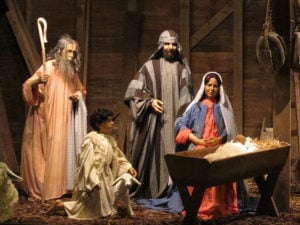
Once they arrived in Bethlehem, the young couple found that all the inns were booked up. Worse, all the local Airbnbs were price-gouging because OliveOilCon® was in town, the industry's premier trade show in the Middle East.
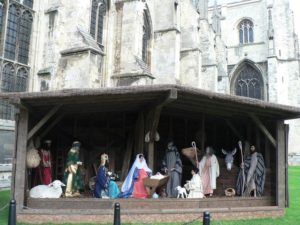
With no more affordable or sanitary options, Joseph sweet-talked an innkeeper into letting them spend the night in the man's “stable.” Back then, a stable was defined as “an appalling structure in which revolting animals are sheltered and defecate wildly.”
Yet, despite how the nativity scene has been artistically depicted over millennia (see Nativity Scene at left), Jesus wasn't born in any barn, like an animal. He was actually born in a freakin' cave (see photo below). Yeah, like a freakin' bat.
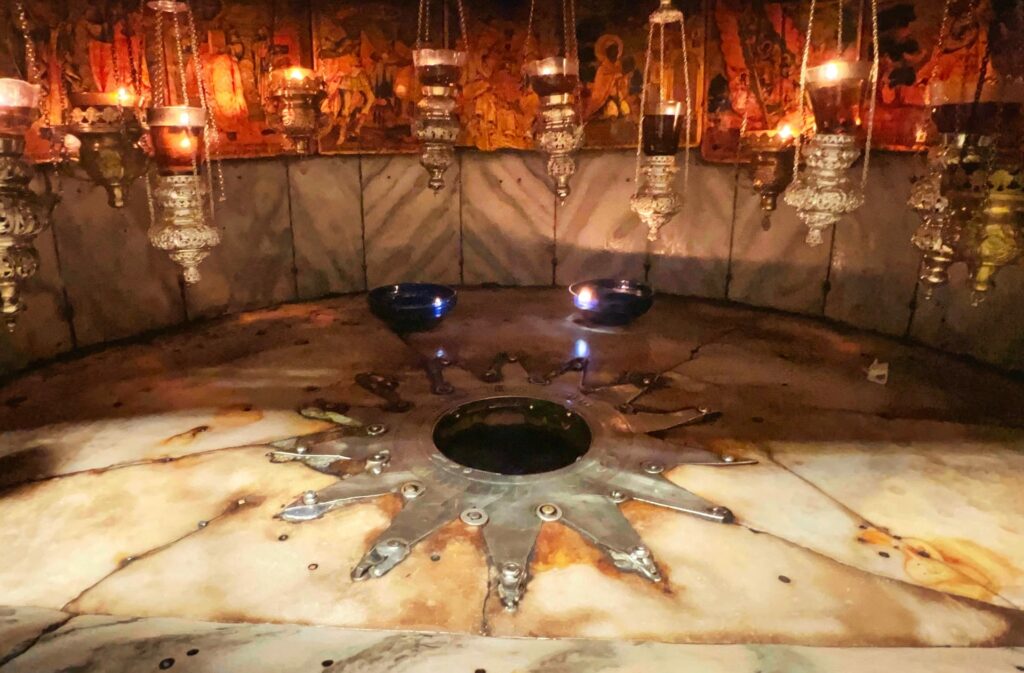
Apparently, people in biblical times used to build structures up against mountains and cliffs that had preexisting caves. That way, they got additional room without having to build any additional rooms. Makes sense, but try putting that description on Zillow and see how fast your home sells. “Now selling: Four bedroom, no bath, 800 sq. ft. mud-hut with bonus 200 sq. ft. cave. [price reduced…again!]”
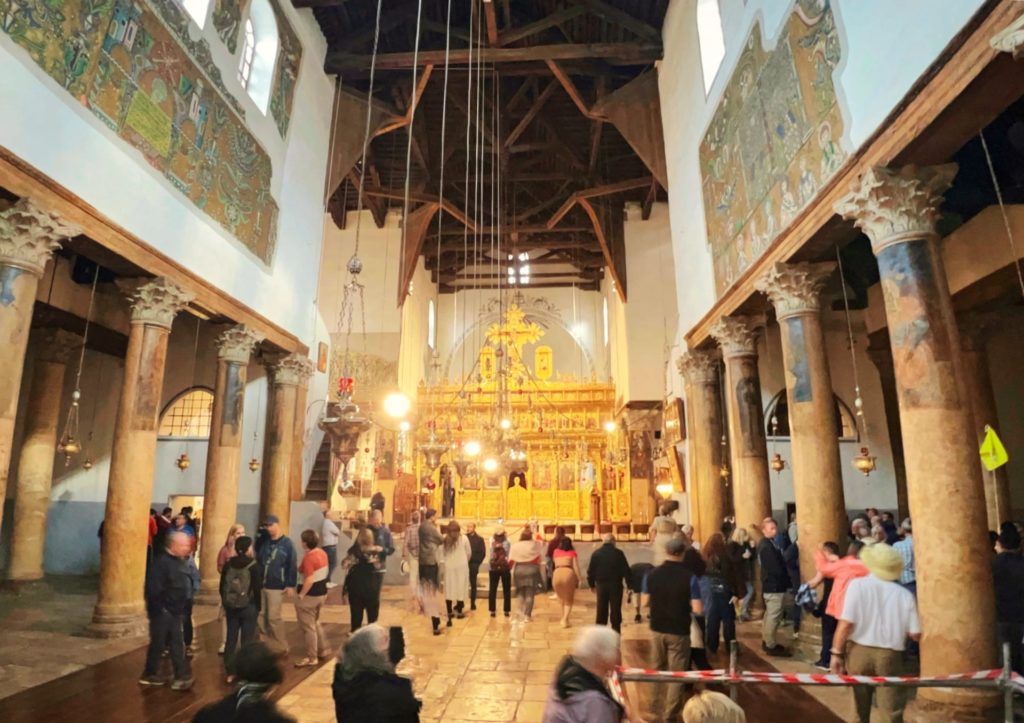
Jesus was born in the basement of a church.
Emperor and poster-child for humility, Constantine The Great, built the Church of the Nativity right on top of the cave where he believed Jesus was born. Constructed in the 4th Century CE, it's the oldest continuously operating Christian church in the world.
The Church has been in use ever since Constantine converted to Christianity. He claimed to have had a vision about kicking the ass of his enemies, and then he did. It's debatable whether Constantine really understood Christ's teachings or not.
Over the following 2,000 years, the compound surrounding the church was expanded to approximately 130,000 square feet. Three monasteries were added, including a Roman Catholic, an Armenian Apostolic, and a Greek Orthodox—collectively known as the three squeakiest wheels.
In 2008, however, the basilica was placed on the 100 Most Endangered Sites watch list. In 2010, an agreement between the church's three custodians was reached for its restoration. Repairs to the roof beams, windows, mosaics, and art objects were completed in 2019. The repairs are expected to last another two millennia, or the contractors all go directly to hell.
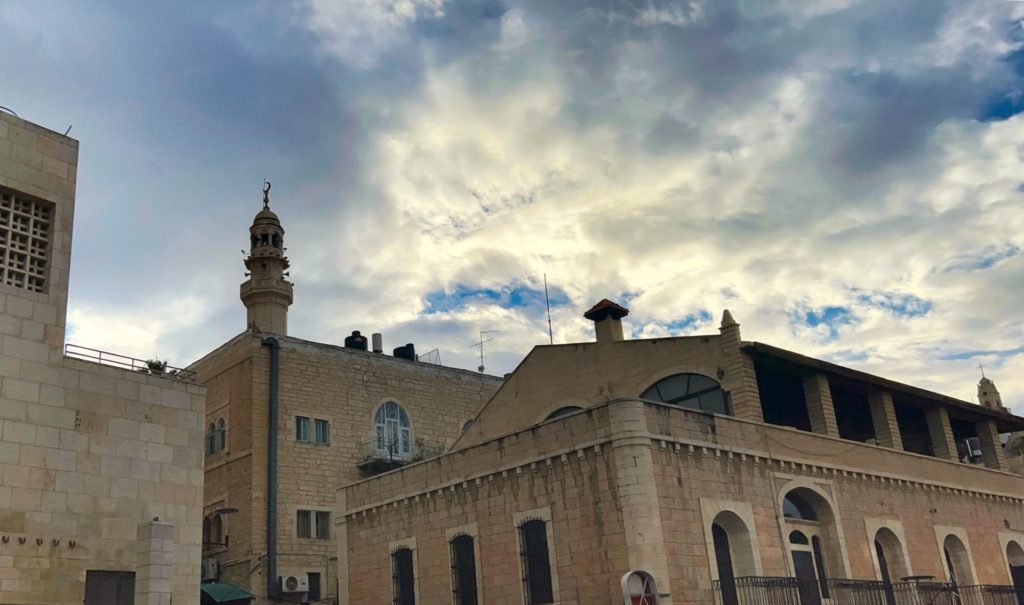
Jesus wasn't born when they told you, either.
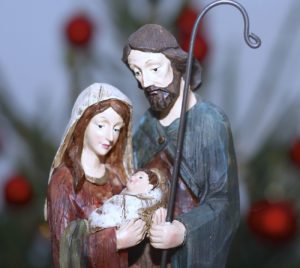
By now, everybody knows that Jesus wasn't born on December 25th—Christmas was a pagan holiday long before monotheism came into vogue. But did you know ancient religious scholars got the year of Jesus' birth wrong, too? Yeah, they weren't real smart back then, apparently.
In 525 CE, a very Christian monk named Dionysius Exiguus did the math and calculated the day and year he thought Jesus was born. The birth of Jesus Christ, he assumed, should mark “Year One” of the new calendar he was proposing. Nothing of consequence, in his opinion, had happened in all of history before that.
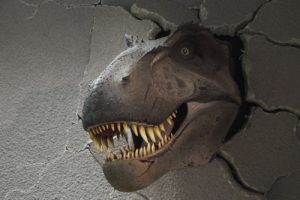
Dionysius figured that Christ was born eight days before New Year's in a year he called “1 AD,” an abbreviation for the latin phrase, Anno Domini, or “in the year of our Lord.” He didn't call it “0 AD,” because Europeans didn't get the concept of zero until 200 years later.
The long time preceding Year One, Dionysius called, “BC,” an abbreviation for the English phrase, “Before Christ.” English was a weird choice for an Iranian-born Italian monk who spoke both Greek and Latin—but not English. Had Dionysius spoken Chinese, however, he might not have messed up the dates so badly.
God forbid, Dionysius looked to the heavens for answers.

Around 5 BC, the Chinese—who very much existed at the time, despite what the Bible doesn't say about them—recorded a slow-moving comet in the Capricorn region of the sky. But because all Asians were heretics doomed to perdition, the Chinese didn't know the significance of what they saw. When Christianity was introduced in the 7th Century, the Chinese finally got the connection.
The comet they saw is now believed to be the infamous Star of Bethlehem, mentioned in the Bible. Its appearance is one of the best factors for calculating Jesus' actual birthdate. That turned out to be somewhere between 7-4 BC. So Dionysius was only off by about 700 years. Luckily, his math error didn't have any lasting repercussions for the Gregorian calendar we still use in 2023 (or, is this only 2016…?)

Bethlehem has changed a lot over the last two millennia.
Visiting Bethlehem was eye-opening, but also disappointing. I'm not sure what I expected, but to me, the city lacked even the slightest mystical aura or feeling of heavenly presence.
FULL DISCLOSURE: I was once told by a psychic girlfriend that, “spirits do not like being around me,” and tend to stay away. So I'm not that surprised Bethlehem just seemed like another old city to me.
I was genuinely surprised to learn how substantially the actual events of Jesus' birth differed from what Americans are (still) taught. I'm sure none of this debunking will have any effect on believers. But if it helps even one innocent child question the accuracy of a book written before the scientific method was established, then my work here is done.




